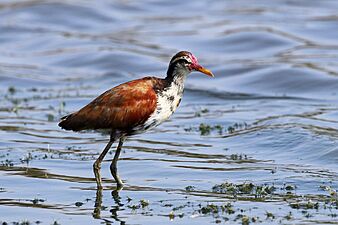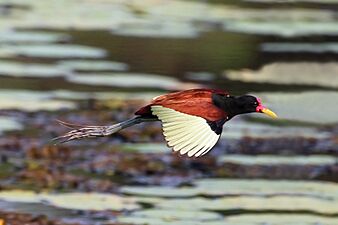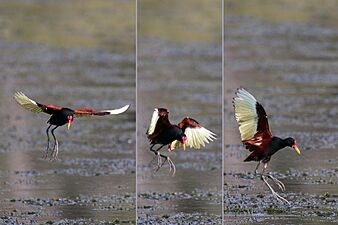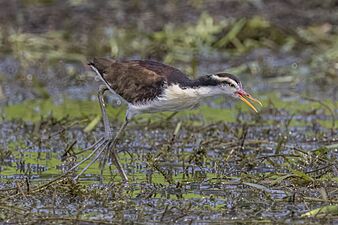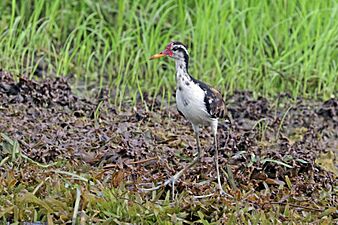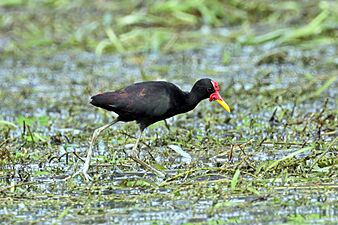Wattled jacana facts for kids
Quick facts for kids Wattled jacana |
|
|---|---|
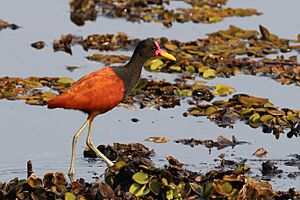 |
|
| Adult J. j. jacana the Pantanal, Brazil |
|
| Conservation status | |
| Scientific classification | |
| Genus: |
Jacana
|
| Species: |
jacana
|
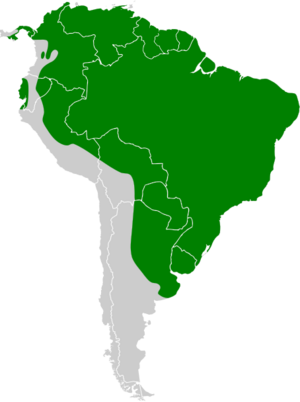 |
|
| Synonyms | |
|
Parra jacana Linnaeus, 1766 |
|
The wattled jacana (Jacana jacana) is a unique water bird found in many parts of South America, especially east of the Andes Mountains. You can also spot them in western Panama and Trinidad. These birds are known for their very long toes and claws. These special feet help them walk easily on floating plants in the water.
Like most jacana birds, the female wattled jacana is bigger than the male. Female jacanas can have up to four or five male partners at once. They also have larger facial crests (a fleshy growth on their face) and bigger wings compared to the males. Their wing spurs, which are used for defense, are also longer.
Contents
What's in a Name?
The name "jacana" comes from the Tupi word ñaha'nã. This word means "very loud bird," which is a good description of the wattled jacana's calls!
Reproduction and Family Life
Wattled jacanas lay four brown eggs that have black marks on them. They build their nests on floating plants in the water.
The male jacana takes care of the eggs. He sits on them to keep them warm, holding two eggs under each wing and against his chest. Female jacanas are special because they can mate with several males. They also help protect the nests of up to four different male partners.
What Does It Look Like?
These birds are easy to spot and remember. They are about 17 to 23 centimeters (6.7 to 9.1 inches) long. Females are larger than males.
Adult jacanas have a chestnut-colored back and wing feathers. The rest of their body is mostly black. When they fly, you can see their bright greenish-yellow flight feathers. They also have yellow, bony spurs on the front edge of their wings. They use these spurs to defend themselves and their young.
Their yellow beak extends up to a red shield on their head, similar to a coot. They also have a reddish wattle (a fleshy growth) on their face. Their legs and very long toes are a dull blue-grey color.
Young wattled jacanas are different. They have white feathers on their undersides. You can always tell a young bird by the white parts in its feathers.
Types of Wattled Jacanas
There are six different types, or subspecies, of the wattled jacana. The most common one is called J. j. jacana. Many of the other types look similar.
However, one type, J. j. hypomelaena, lives in western Panama and northern Colombia. This type has all black feathers where other jacanas have chestnut. Another type, J. j. scapularis, found in western Ecuador, has some black feathers on its chestnut shoulders and white outer primary feathers.
Main Subspecies
- J. j. hypomelaena (Gray, 1846): Found from west-central Panama to northern Colombia.
- J. j. melanopygia (Sclater, 1857): Lives from western Colombia to western Venezuela.
- J. j. intermedia (Sclater, 1857): Found in north and central Venezuela.
- J. j. jacana (Linnaeus, 1766): This type is found in Trinidad, southern Colombia, southern Venezuela, and through the Guianas south to eastern Bolivia, northern Argentina, and Uruguay.
- J. j. scapularis (Chapman, 1922): Lives in western Ecuador and northwestern Peru.
- J. j. peruviana (Zimmer, 1930): Found in northeastern Peru and northwestern Brazil.
These birds make a variety of loud, rattling sounds.
What Do They Eat?
The wattled jacana eats mostly insects like beetles, grasshoppers, and crickets. They also eat other small creatures without backbones, such as ticks and mollusks. Sometimes, they will eat small fish, roots, and seeds. They find their food by picking it off floating plants or from the water's surface.
-
Immature J. j. hypomelaena
Chagres River, Panama -
Subadult J. j. hypomelaena
Chagres River, Panama -
Adult J. j. hypomelaena
Chagres River, Panama



